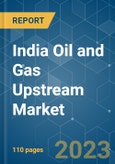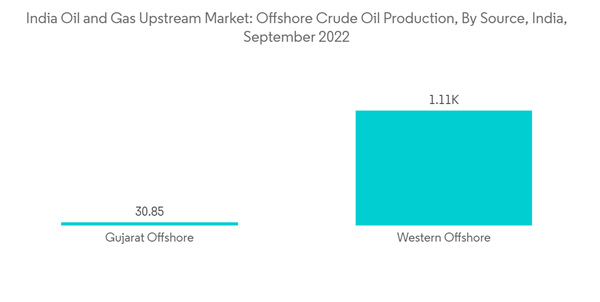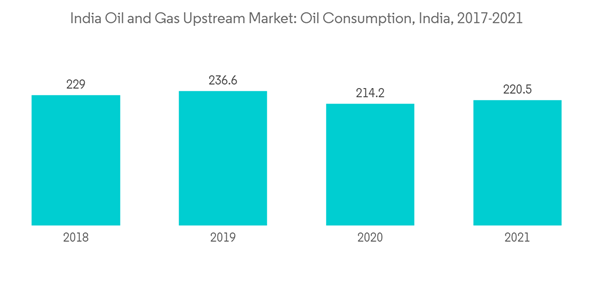The oil and gas upstream market in India is expected to record a CAGR of more than 1% during the forecast period.
The market was negatively impacted by COVID-19 in 2020. Currently. The market has reached pre-pandemic levels.
This product will be delivered within 2 business days.
The market was negatively impacted by COVID-19 in 2020. Currently. The market has reached pre-pandemic levels.
Key Highlights
- Over the long term, factors such as increasing oil consumption and government efforts to reduce dependence on energy imports are expected to drive the market during the forecast period.
- On the other hand, a lack of new discoveries, coupled with insufficient exploration activities, is expected to restrain the market's growth during the forecast period.
- Nevertheless, the thorough exploration and development of hydrocarbon reserves across the large acreage spread across 16 prospective onshore basins in India remains a significant growth opportunity for the market during the forecast period.
India Oil & Gas Upstream Market Trends
Offshore Production to Dominate the Market
- In May 2022, India produced nearly 2550.5 thousand metric tons of crude oil, of which offshore production accounted for around 1257.68 thousand metric tonnes (49.2%) of the oil produced and almost 68.3% of the gas produced in India. India has 26 sedimentary basins, of which only seven have commercial production of oil and gas. According to MOPNG, crude oil production from offshore increased by nearly 4.6% from May 2021, while natural gas production rose by almost 7.9% in the same period.
- The oil products market is expected to dominate the market due to its large share in the oil and gas business. Oil demand is also likely to remain higher than natural gas demand. However, the rate of growth in demand for natural gas is expected to be much higher, which is due to the government lead initiatives like the Urja Ganga gas project.
- In November 2022, the country launched a new licensing round in accordance with the India Open Acreage & Licensing Policy (OALP). The round will include 23 blocks and cover almost 220,000 square kilometers. A total of 15 blocks lie in ultra-deep waters; eight others are shallow-water acreages.
- According to the Ministry of Petroleum and Natural Gas, as of 2022, the offshore oil production in the eastern offshore region was 38.19 thousand metric tons; similarly, in Gujarat, offshore and the western offshore region was 30.85 and 1110.14 metric tons, respectively.
- Hence, offshore oilfields are expected to dominate the market due to economically viable gas basins being concentrated in the water bodies of the exclusive economic zone of India.
Increase in Oil Consumption to Drive the Market
- Oil Consumption in the country increased by 2.9% to 220.5 Million tonnes oil equivalent, in 2021 from 214.2 Million tonnes oil equivalent, in 2020. The steady increase in consumption is expected to be the most prominent driver in the forecast period.
- In 2021, Oil production became 619 thousand barrels/day, which decreased from 744 thousand barrels/day, in 2017. The decrease in production is consistent over the 2017 - 2021 period. Poor reservoir performance, high water cut, and human errors are the primary reason for the decline.
- Changes in the policies for exploration and production have led to some growth in the industry. Companies look prudent as changes may bring ease in the sector. In a significant overhaul of oil and gas exploration permits, the government decided, in 2019, not charge any share of profit on hydrocarbons produced from less explored areas as it looks to attract the elusive private and foreign investment to raise domestic output.
- India’s state-run Oil & Natural Gas Corp. has finalized a series of international partnerships in an effort to draw the expertise of some global oil majors to expand upstream output. ONGC recently signed an agreement with Chevron New Ventures PTE Limited, a subsidiary of California-based energy major Chevron Corporation, to assess exploration potential in India.
- The company has also sealed an agreement with Equinor ASA for collaboration in the areas of E&P, midstream, downstream and clean energy options, including carbon capture, utilization and storage. ONGC has also sealed a heads of agreement with ExxonMobil for deepwater exploration on the eastern and western coasts of India. The collaboration will focus on the Krishna Godavari and Cauvery basins in the eastern offshore and the Kutch-Mumbai region in the western offshore.
- Hence, oil consumption is expected drive the oil and gas market. Increase in investment in the sector is also expected to increase the growth in the industry.
India Oil & Gas Upstream Market Competitor Analysis
The India oil and gas upstream market is consolidated. The major players (in no particular order) include Oil and Natural Gas Corporation, Reliance Industries Limited, Oil India Limited, Larsen & Toubro Limited, and BP PLC, among others.Additional benefits of purchasing the report:
- The market estimate (ME) sheet in Excel format
- 3 months of analyst support
This product will be delivered within 2 business days.
Table of Contents
1 INTRODUCTION
4 MARKET OVERVIEW
5 MARKET SEGMENTATION
6 COMPETITIVE LANDSCAPE
Companies Mentioned (Partial List)
A selection of companies mentioned in this report includes, but is not limited to:
- Oil and Natural Gas Corporation
- Oil India Limited
- Vedanta Limited
- Reliance Industries
- BP PLC
- Deep Industries Ltd
- Jindal Drilling & Industries
- Hindustan Construction Co. Limited
- Larsen & Toubro Limited
Methodology

LOADING...










